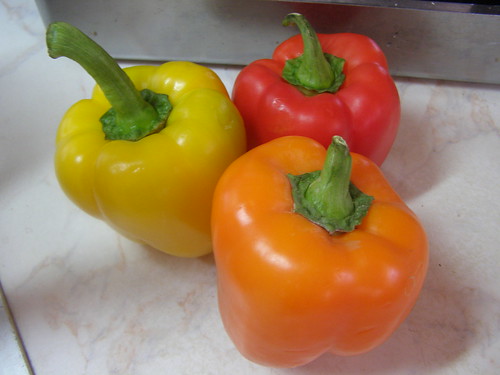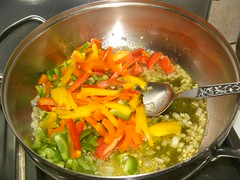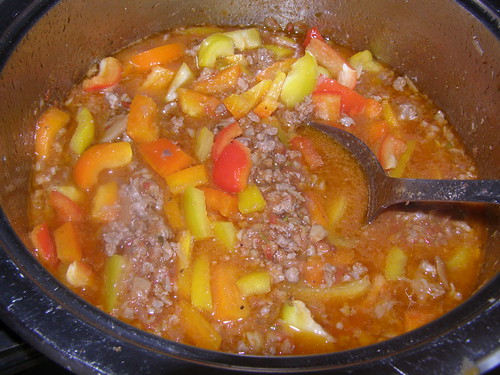Heat in Greek food is generally limited to the temperature at which it is served. Chili powders and hot sauces are not generally part of the local cuisine of Crete, although they are all now readily available in our supermarkets, but traditional Greek food as it is served in local restaurants is generally not spicy. Foreigners in Greece, more travelled locals and immigrants all bring more tastes into the country, and people are now more willing to try novel tastes.
I am always hesitant about adding too much heat in our food in the form of chili because I worry about how the children will react to it. They've tasted a wide range of cuisines through our trips abroad, but it's one thing to eat out in a foreign country and another thing to eat at home in your own country. My husband was hooked on Indian food the first time he tried it in New Zealand at a food court. Indian stews and vegetable curries reminded him of similar textures in Greek food but without the heat, which added an extra dimension to the flavour. My kids needed a bit more convincing, and I'm happy to say they have become more accepting of hot tastes, so I now can cook one spicy meal for the lot of us. But I still always ask the kids if they mind my making something spicy. "Not too hot!" they always say, which sometimes leads me to under-spicing my food, to my dismay.
I always wondered how children born in cultures whose cuisines are well known for being spicy get used to heat in their food. An Australian friend recently told me what her Indian friend - now a grandmother - did to get her children accustomed to eating hot'n'spicy food. She started her children on hot food when they were about 2 years old. The amount of chili added to their meal serving was the size of a pin-prick, as much as will cling onto a single tine of a fork. This is done daily for a few days, before a second tine of chili is added to their meal, and the process is repeated. Eventually, children become accustomed to heat in food, and they eat the same meals as their parents.
I was recently given a sachet of ready-to-use curry laksa paste, a Singaporean/Malaysian specialty, which I was looking forward to trying now that the cold weather that has set in. Heat in food is often associated with cold weather for most Greeks, although I do understand that it is eaten all year round in places like India. I defrosted some pork, cut it up, browned it in olive oil with some chopped onions, and then I opened up the sachet to add to the meat. It looked like a lot of paste to me, and of course, it smelt different to what I usually use to spice my food, not to mention the hot smell that it gave off. I didn't add it all, out of fear that I may make the meal inedible for the family.
If I didn't get the proportion of heat right for the family's tastes, I would end up with a meal that would not be eaten. This is also acceptable because even in spicy cuisines, the heat ingredient is often left on the table so that diners can add as much as they want. I spent most of my Sunday morning fretting about how much this meal would be enjoyed. I wanted to have the curry as a soup, which meant that I would add vegetables and noodles to it, but I couldn't imagine the family eating curry laksa soup, on which point I was right: they asked for plain boiled rice to go with the meat. We are all creatures of habit in some way; novelties need to be introduced to us at the right place at the right time.
Finally, the moment to serve the meal came, and I waited with bated breath to hear the verdict. Too hot or just right? And what do you think they said? "Mum, didn't you say this was supposed to be a spicy meal? There's hardly any chili in it!" Oh well, at least I have just enough paste left over for another curry laksa - next time, it will definitely be hotter!
©All Rights Reserved/Organically cooked. No part of this blog may be reproduced and/or copied by any means without prior consent from Maria Verivaki.
I am always hesitant about adding too much heat in our food in the form of chili because I worry about how the children will react to it. They've tasted a wide range of cuisines through our trips abroad, but it's one thing to eat out in a foreign country and another thing to eat at home in your own country. My husband was hooked on Indian food the first time he tried it in New Zealand at a food court. Indian stews and vegetable curries reminded him of similar textures in Greek food but without the heat, which added an extra dimension to the flavour. My kids needed a bit more convincing, and I'm happy to say they have become more accepting of hot tastes, so I now can cook one spicy meal for the lot of us. But I still always ask the kids if they mind my making something spicy. "Not too hot!" they always say, which sometimes leads me to under-spicing my food, to my dismay.
I always wondered how children born in cultures whose cuisines are well known for being spicy get used to heat in their food. An Australian friend recently told me what her Indian friend - now a grandmother - did to get her children accustomed to eating hot'n'spicy food. She started her children on hot food when they were about 2 years old. The amount of chili added to their meal serving was the size of a pin-prick, as much as will cling onto a single tine of a fork. This is done daily for a few days, before a second tine of chili is added to their meal, and the process is repeated. Eventually, children become accustomed to heat in food, and they eat the same meals as their parents.
Stewed pork with some curry laksa paste, and boiled broccoli and cabbage with a hint of curry laksa flavour. The paste contained dried chili, prawn paste, turmeric, lemongrass, garlic, onion, galangal, oil, sugar and salt (and flavour enhancer E261). I felt sure that a taste/aroma was missing from the curry, something like coconut milk - thanks to facebook, I got some instant replies: yes, coconut milk is added to such a paste, and if you don't have that, you can add potatoes to the stew, so that when they cook through and break down, their starch thickens the sauce. Thanks to Alex for the paste and Kristen for the coconut powder.
I was recently given a sachet of ready-to-use curry laksa paste, a Singaporean/Malaysian specialty, which I was looking forward to trying now that the cold weather that has set in. Heat in food is often associated with cold weather for most Greeks, although I do understand that it is eaten all year round in places like India. I defrosted some pork, cut it up, browned it in olive oil with some chopped onions, and then I opened up the sachet to add to the meat. It looked like a lot of paste to me, and of course, it smelt different to what I usually use to spice my food, not to mention the hot smell that it gave off. I didn't add it all, out of fear that I may make the meal inedible for the family.
My curry laksa soup was not really soupy, or even as red as it should be, but it tasted great.
If I didn't get the proportion of heat right for the family's tastes, I would end up with a meal that would not be eaten. This is also acceptable because even in spicy cuisines, the heat ingredient is often left on the table so that diners can add as much as they want. I spent most of my Sunday morning fretting about how much this meal would be enjoyed. I wanted to have the curry as a soup, which meant that I would add vegetables and noodles to it, but I couldn't imagine the family eating curry laksa soup, on which point I was right: they asked for plain boiled rice to go with the meat. We are all creatures of habit in some way; novelties need to be introduced to us at the right place at the right time.
Finally, the moment to serve the meal came, and I waited with bated breath to hear the verdict. Too hot or just right? And what do you think they said? "Mum, didn't you say this was supposed to be a spicy meal? There's hardly any chili in it!" Oh well, at least I have just enough paste left over for another curry laksa - next time, it will definitely be hotter!
©All Rights Reserved/Organically cooked. No part of this blog may be reproduced and/or copied by any means without prior consent from Maria Verivaki.


































